Home >> Fields, capacitors 1
action |
||
Action
Capacitors are electrical components used to store charge. Their construction is simply two equal area conducting plates, with an insultor(dielectric) sandwiched in between.
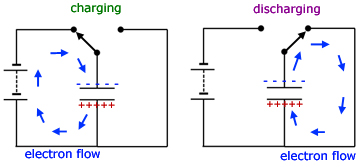
When the switch is turned to the left, there is an instantaneous flow of current. By the action of the battery electrons move in a clockwise sense. They are taken from the lower plate and deposited on the upper one.
In a very short time all motion ceases. The p.d. across the plates is now the same as that across the battery, but in the opposite direction. With the positive of the battery connected to the positive of the capacitor, no p.d. exists. So no current flows.
In this state the capacitor is said to be 'fully charged'. Charges on upper and lower plates are of opposite type and equal in quantity.
Capacitance
Capacitance is the measure of a capacitor to store charge. The larger the capacitor the more charge can be stored per volt of p.d. across the plates.
![]()
where,
C is the capacitance in Farads (F)
Q is the charge in Coulombs (C)
V is the p.d. between the plates
The unit of capacitance is called the Farad.
By definition, a capacitor has a capacitance of 1 Farad when 1 Coulomb of charge is stored with a p.d. of 1 volt across the plates.
Hence the units of Farads are Coulombs per volt (CV-1)
One Farad is too large a unit for ordinary circuits. Instead smaller derivative units are used, eg microfarads (μF) and picofarads (pF).
The Parallel Plate Capacitor
The capacitance of a parallel plate capacitor can easily be derived from first principles
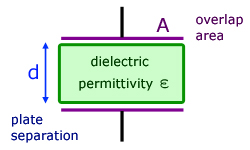
Starting with our basic equation for capacitance,
![]() (i
(i
The charge Q is equal to the charge density σ multiplied by the area A .
![]()
Substituting for Q in the first equation (i ,
![]() (ii
(ii
Results from Gauss's Theorem* give electric field strength E in terms of charge density σ and permittivity ε :
* an advanced theory not dealt with here
![]()
Rearranging to make σ the subject,
![]()
Now substituting for σ in equation (ii
![]() (iii
(iii
For the uniform field inside a capacitor,
![]()
hence,
![]()
Substituting for V into equation (iii
![]()
![]()
Note: the expression for electric field strength E from Gauss's law is for an infinite plate area A . This result is therefore an approximation.
Relative Permitivity
The definition of relative permittivity is the ratio of the capacitance of a capacitor with a dielectric to that of a capacitor without (ie free space).

By looking at capacitance we can obtain an expression linking relative permittivity εr , the permittivity of free space εo and the permittivity of the dielectric being used.
![]()
We find εr by dividing the first equation by the second :


Note: because εr is a ratio of permittivities, it has no units
Dielectrics
To understand the action of dielectric materials it is important to appreciate what is happpening on the molecular level.
When an electric field is applied to a dielectric the positioning of the components of atoms/molecules is changed.
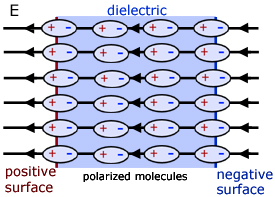
Positive atomic nuclei are moved to their limit a short distance and point towards the negative plate. Electron clouds around atoms become mis-shapen with the bulk of their charge pointing towards the positive plate. In this way atoms/molecules become polarized, with opposite charges tending to be concentrated at either end.
The result is that the surfaces of the dielectric facing the capacitor's plates become charged. A positive plate opposes the negative face of the dielectric, while a negative plate opposes the dielectric's positive face.
A dielectric between the plates of a capacitor modifies capacitance in two particular circumstances:
An isolated charged capacitor
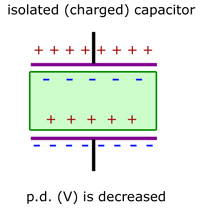
The negative charge on the top surface of the dielectric combines with the positive charge on the top plate to lessen the overall potential in the area. (The area is less positive.)
The positive charge on the bottom surface of the dielectric combines with the negative charge on the bottom plate to increase the potential there. (The area is less negative.)
The result is that there is less potential difference (V) across the capacitor. Since Q = CV , Q is unchanged and V decreases, then C increases.
A capacitor in-circuit with a battery
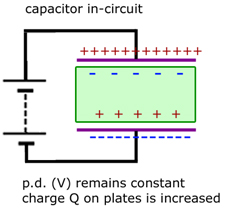
The p.d. V across the plates is maintained by the battery. The surface charges on the dielectric cause more electrons to be drawn from the positive plate and be deposited on the negative plate.
So the overall charge Q on the plates is increased. Since V is constant and Q = CV then C increases.
For different reasons, the effect of introducing a dielectric substance between the plates of a capacitor has the effect of increasing the capacitance.
Below is a table of common relative permittivities.
Note how the relative permittivity for water is much higher than the rest. This is because water(along with many other liquids), has polar molecules . These are polarized. That is they have + and - ends. without any field being applied. Polar molecules in liquids readily align themselves to an electric field. In this way more surface charges are produced and the effect is greater.
material
|
rel. permittivity |
vacuum |
1.0 |
|
|
air |
1.00058986 (STP) |
ebonite |
3 |
glass |
5 |
mica |
7 |
paper |
3.85 |
polythene |
2.25 |
polystyrene |
2.4 - 2.7 |
rubber |
7 |
water |
80.1 (room temp.) |
this week's promoted video
[ About ] [ FAQ ] [ Links ] [ Terms & Conditions ] [ Privacy ] [ Site Map ] [ Contact ]
